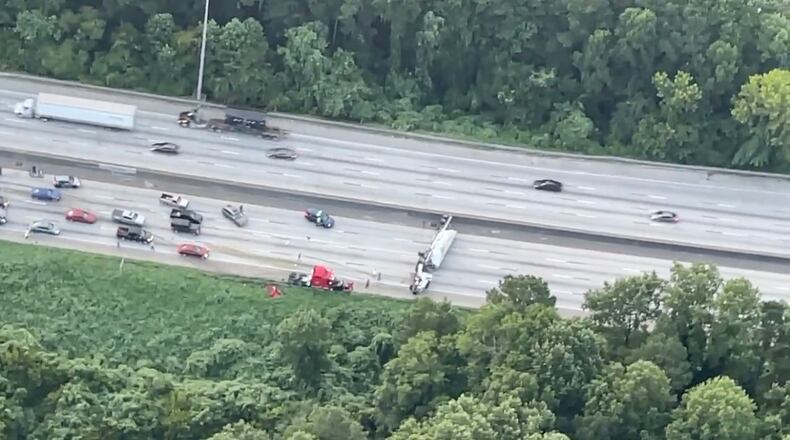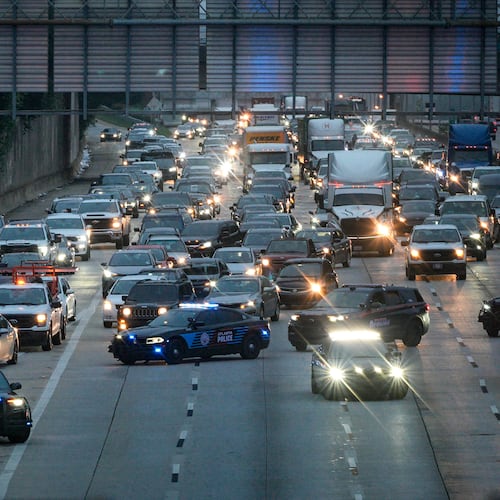A full interstate closure, what we call a traffic RED ALERT, interrupted a busy stretch of I-285 on the first day of school in Fulton County last Monday, just before 8 a.m. These ephemeral cataclysms happen fairly often. But the horrible decisions of a few people caught behind this are what make this wreck infamous.
“‘Wow!’ was the word I recall saying when we arrived on the scene of Monday’s overturned truck crash in the WSB Skycopter. It rolled all right ... landing across all lanes of I-285/southbound before Langford Parkway. When I say all lanes, that includes the shoulders on both sides of the roadway. Perhaps the only vehicle that could have gotten through the crash scene would have been a motorcycle,” WSB Triple Team Traffic’s Smilin’ Mark McKay recalled from having flown over the scene.
Then McKay noticed something that raised his eyebrows more than a flipped truck blocking a busy freeway did: “Several motorists had made the fateful decision to get onto the right shoulder when they saw traffic slowing up ahead of them. They’d soon discover there was nowhere to go and were stuck. That decision prevented first responders from gaining access to the crash from the north. It didn’t sit well with me.”
It didn’t sit well with Atlanta Fire Department’s Sergeant Cortez Stafford either, who tweeted as much a few hours later.
Stafford said this stretch of I-285 is extremely busy, carries many tractor trailers, and requires AFD’s attention often.
“There is no day where we don’t respond to accidents involving tractor trailers, whether they be major or minor,” Stafford, AFD’s Public Information Officer, told the AJC and 95.5 WSB. He noted there were other crashes in the area on side roads demanding an AFD response simultaneously with the one that shut down I-285.
AFD Station 25 needed to access the crash on I-285/southbound (Outer Loop) before Highway 166, from Cascade Road. Stafford explained that the left median on that stretch of I-285 is not a proper emergency lane, as it is only about 3 feet wide; responding fire equipment needed to use the larger and proper right emergency lane. That disappeared as an option.
“Truck 25 ... was a quarter-mile from the scene and was dead in the water,” Stafford explained about the stopped firetruck. “The captain of that truck had to go up to cars and basically direct them to part the way.”
Trying to direct these stopped cars first appeared so quixotic that the firefighters onboard were prepared to grab their equipment from the truck and walk down to the scene.
“I can’t tell you how important it is to have our toolbox, which is our truck,” Stafford said.
A driver in one of the crashed trucks was reported trapped, so rescuers were preparing to walk the jaws-of-life tools a quarter-mile down the freeway. Because the firetruck finally got to the scene an hour after the crash, the trapped driver had already been freed.
“It’s absolutely essential that we have that lane open when we respond to accidents,” Stafford said, because of the inevitable gridlock incidents create in the other lanes. “If that emergency lane is taken up, as it was on (Monday) morning, then we’re done for and we cannot get to the front of the cause.”
Stafford said that people dart into the lane thinking they will save time, but have no idea that the freeway very well could be shut down in front of them, making their moves moot.
“I believe that people, overall, culturally, are just in a rush,” Stafford said. “I also feel that people are a little bit entitled to get where they’re going, with lack of regard for what’s happening in front.”
Stafford says he thinks that people stuck in jams truly don’t think about anything other than getting to point B — they don’t consider that someone ahead of them could be hurt and needs immediate attention.
“We get complaints about our response times ... traffic is a major issue in Atlanta. We have to get there safely, so we can get to you to help. We can only do that if people abide by the rules,” Stafford said.
Stafford also says that people have a general misunderstanding of what to do when they see flashing emergency lights. The 17-year AFD veteran said that people need to use case-by-case judgment when they see or hear police, fire, EMS, HERO, tow trucks, or other emergency vehicles. On side roads, drivers should pull as far to the right as they can, he said. On freeways, drivers should gauge what lane the apparatus is in behind them and then clear out of the way of that lane. And they should always leave the right emergency lane open. Stafford also noted that people at a stop light are legally allowed to pull out into the middle of an intersection to clear a lane for emergency responders. Flashing emergency lights take precedence over traffic lights.
The worst thing a driver can do, Stafford said, is to stop in the same place in the middle of the road. People get nervous and freeze, blocking the lane, obstructing the responders, and making the problem worse: “We will literally be behind them, on the horn, and they’re just frozen. When we get out to them they’re like, ‘Well, I didn’t know what to do.’”
Based on Stafford’s observations over the years, drivers seem more likely to yield to the flashing blue lights of police, probably because they know police can issue tickets. The fire veteran says he wishes that law enforcement would ticket more violators for blocking emergency lanes or not yielding to rescue equipment, but he knows that is a tough task. Police, sheriff’s officers, and the State Patrol are usually occupied with the crash scene itself. Both APD and GSP said that no drivers got cited for blocking the emergency lanes during that incident last week.
“We need to make sure that law enforcement knows our plight, and I don’t want to assume that they know,” Stafford said.
Stafford says he thinks there is a key factor to improving this driver-behavior: alerting and educating drivers. If motorists know what is ahead of them — whether that be via overhead signs or radio traffic reports from the WSB Traffic Team — then they are more likely to react accordingly. This is why preparation before and during a commute is key. Bad traffic makes worse traffic. And bad drivers make for worse situations.
When drivers choose to selfishly drive in emergency lanes, they potentially cost lives and they make the shutdown last longer, which inconveniences others and themselves.
The egregious acts by those people on I-285 delayed Atlanta Fire’s response by nearly an hour; a trapped driver could have died and thankfully did not. We have to do better.
Doug Turnbull, the PM drive Skycopter anchor for Triple Team Traffic on 95.5 WSB, is the Gridlock Guy. He also hosts a traffic podcast with Smilin’ Mark McKay on wsbradio.com. Contact him at Doug.Turnbull@cmg.com.
About the Author
The Latest
Featured


